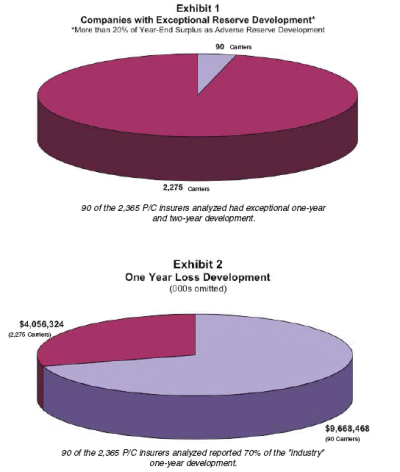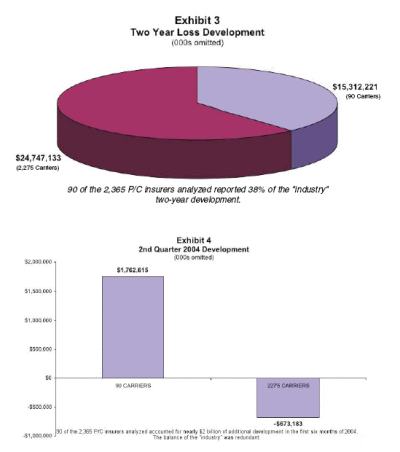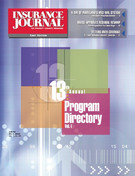Placing Industry Loss and Loss Adjustment Expense Reserving into Perspective
In an April 2004 edition of Insurance Journal, Mark Wells, publisher, utilized the ‘On the Street’ column to frame the issues related to the current situation of the property/casualty insurance industry’s loss and loss adjustment expense reserves. This column will provide further analysis based on his observations.
Wells’ concerns about the solvency of P/C insurance companies focused on loss and loss adjustment expense reserve levels (reserve levels). His article accurately framed the underlying issues through specific word selection. He wrote of “carrier solvency,” not of “industry solvency.” He wrote about the reserve levels of carriers, not the reserve level of the industry.
This is the proper perspective since the industry does not estimate loss reserves–carriers estimate loss reserves. The industry’s position is merely the aggregation of the estimates of a defined group of individual carriers. Therefore, the reasonableness of loss reserves should not be addressed as an industry issue, but rather an issue that impacts a small, identifiable percentage of the insurers comprising the industry.

Companies analyzed
This article summarizes an analysis of 2,365 P/C insurance companies as of June 30, 2004. Each of the included carriers met the following criteria:

Data utilized
The information underlying this study is the loss and loss adjustment expense reserve levels reported by the carriers. This is a historical analysis. The study did not utilize projections or actuarial assumptions. The study utilized a carrier by carrier analysis to compare reported reserve runoff to the carriers’ historical reported reserves. If a carrier underestimated its loss reserves, the resulting dollar difference was based on the carrier’s revised estimate versus the carrier’s initial estimate.
Similarly, if a carrier reported redundant reserves, the redundancy was measured by the comparison of the carrier’s revised estimate versus the carrier’s initial estimate.
The source for this data was the statutory financial statements prepared by the carriers and filed with the National Association of Insurance Commissioners (NAIC).
Uniform criteria
For purposes of establishing uniform criteria for determining the companies that were reasonably reserved versus those which were not reasonably reserved, the study calculated Insurance Regulatory Information System (IRIS) ratios related to loss reserves for each of the 2,365 carriers.
The study identified 90 insurers that reported exceptional values as measured by one-year loss reserve development to surplus, two-year loss development to surplus as well as adverse reserve development as of June 30, 2004. Refer to Exhibit 1 to view the comparison of this group to the industry.
These 90 insurers reported loss and loss adjustment expense reserve development of more than 20 percent of the reported surplus, on a one-year retrospective basis and a two-year retrospective basis. Although there were only 90 insurers in this group, these 90 insurers accounted for 70 percent of the “industry’s’ one-year development and nearly 40 percent of the “industry’s’ two-year development. Refer to Exhibit 2 for the comparison of one-year loss development and Exhibit 3 for the comparison of two-year loss development.
As one might surmise, the group of 90 included larger, well-known insurers. As few substantial insurance companies account for a significant portion of the “industry’s’ adverse development, it may be said that those companies could be the focus of financial examinations.
When is more enough?
Given that the 90 insurance companies had underestimated their year-end 2001 loss and loss adjustment expense reserve estimate, had to increase reserves during 2002 and 2003, and then underestimated their year-end 2002 loss and loss adjustment expenses and increased those reserves during 2003 … were they able to get their reserve position at year-end 2003 about right?
Not according to the information that they compiled and reported to regulators! Based upon their own analysis of the reserves that they had estimated and reported at year-end 2003, the group of 90 indicated that as of June 30, 2004, they increased their year-end 2003 reserves by an additional amount of nearly $2 billion.
In contrast to the strengthening by the group of 90, the remaining 2,275 carriers reported a modest redundancy of $673.183 million. Stated another way, as of June 30, 2004, 2,275 insurance companies reported that their year-end 2003 loss and loss adjustment expense reserves seemed to be about right, maybe even a touch high. Accordingly, the group of 90 accounted for all of the industry’s reported development for the period ending June 30, 2004. Refer to Exhibit 4 for details.
Further observation
While an analysis of the P/C insurance industry’s aggregate loss and loss adjustment expense reserve position can be interesting reading, it is no substitute for an analysis of carrier solvency. Carriers set reserves. The industry does not. Carriers are solvent or insolvent. The industry is not solvent or insolvent. Claimants do not receive payment for meritorious claims from the industry. Claim checks are issued by specific carriers.
In his April 5, 2004 article, Mark Wells asked if the departments of insurance were monitoring solvency. We think this is the case. The success of the departments of insurance (DOI) is measured by the small number of carriers reporting exceptional reserve development. Further, additional monitoring and standards have been put in place with more regulations and guidelines being introduced. Professional actuaries are on staff at many DOIs and appear to be assuming a greater role in solvency analysis.
Another question that Wells asked was whether rating agencies are monitoring solvency. Perhaps a response to this question is less enthusiastic. ‘We hope so.’ However, based upon the number of publicly traded insurance companies in the group of 90, it appears that other rating agencies are focused on current period profitability and the next release of quarterly earnings.
Questions related to adverse reserve runoff should be asked. A focus on solvency requires realistic reserve levels as opposed to a fascination with quarterly earnings. Insurance companies should not meet earnings estimates by artificially decreasing loss and loss adjustment expense reserve levels.
Conclusion
Informed third parties interested in the reserve position of the P/C insurance industry should be aware that the overwhelming majority of the reported inadequacy in loss reserves was reported by companies that comprise a small percentage of the industry. The topic for discussion may be industry loss reserves, but the focus of our attention should be carrier solvency.
Informed parties should not confuse these two separate and distinct issues. Mark Wells did not confuse the two issues and we think he had it right.
Joseph L. Petrelli, president and founder of Demotech Inc., is a member of the Casualty Actuarial Society, American Academy of Actuaries and the Conference of Consulting Actuaries. As this article presents actual
reported historical information, it was not intended to be a statement of actuarial opinion, and should not be interpreted as one. www.demotech.com.
Was this article valuable?
Here are more articles you may enjoy.


 South Carolina Ringleader Sentenced to 8 Years for Staged Accidents
South Carolina Ringleader Sentenced to 8 Years for Staged Accidents  4,800 Claims Handled by Unlicensed Adjusters in Florida After Irma, Lawsuit Says
4,800 Claims Handled by Unlicensed Adjusters in Florida After Irma, Lawsuit Says  Vintage Ferrari Owners’ Favorite Mechanic Charged With Theft, Fraud
Vintage Ferrari Owners’ Favorite Mechanic Charged With Theft, Fraud  Chubb to Acquire MGA Healthy Paws From Aon
Chubb to Acquire MGA Healthy Paws From Aon 



